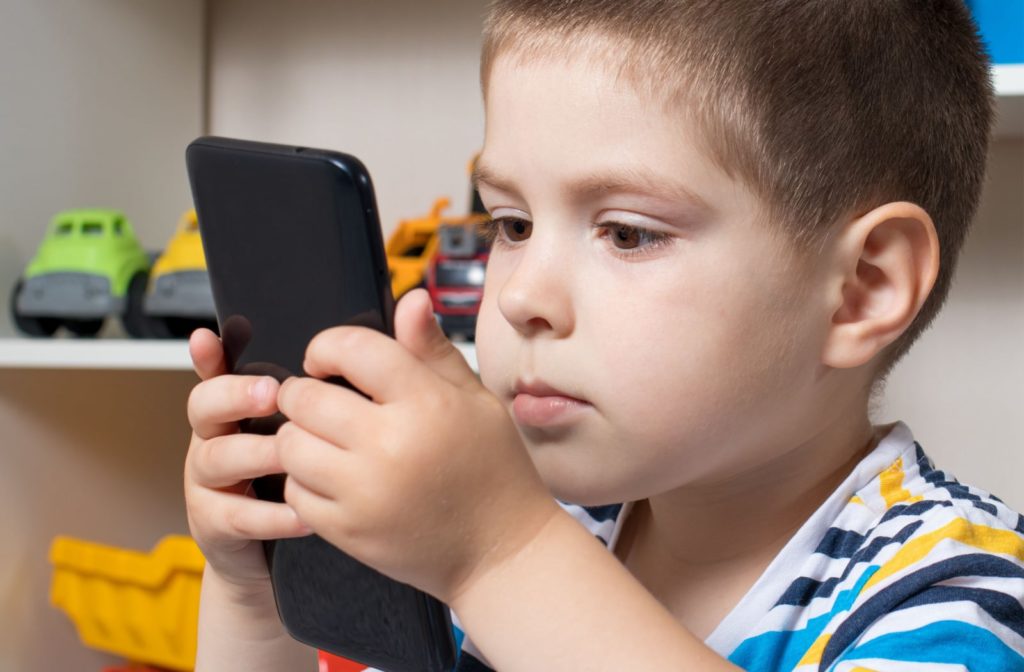If you have myopia, also known as nearsightedness, you might wonder if your children will inherit the condition. Your child will have many eye exams as they grow up, and knowing what signs and symptoms to look out for is vital to protecting their eye health.
Your child’s eyesight is not something you take for granted, and your optometrist can help you protect it. People with family members who have myopia are at a higher risk of developing the condition. However, anyone can be nearsighted. It’s a common eye condition affecting nearly 30% of Canadians.
How Myopia Affects Vision
Myopia is what’s known as a “refractive error.” In a healthy eye, light enters through the cornea (the clear dome at the front of your eye) and passes through a crystalline lens. These two pieces work together to bend or refract the light rays. These light rays then converge on a layer of photoreactive cells at the back of the eye called the retina.
But what happens if light rays don’t come together on the retina? This is what happens to people with refractive errors. For people with myopia, one of two things has likely occurred. Their eyes have grown too long, becoming an oval rather than a circle, or their cornea has become misshapen. These both result in the light converging in front of the retina instead of on it.
This error is a condition where you can see near objects clearly, while distant objects are blurry. The most common symptoms of myopia are:
- Faraway objects look blurry
- Squinting to see clearly
- Headaches
- Eyestrain
Children tend to have trouble explaining if they have vision problems, as it’s the only vision they have ever known. Since myopia usually first presents during childhood, you may have to keep an eye out for further signs:
- Squinting
- Excessive blinking
- Lack of awareness of faraway objects
- Eye rubbing
- Sitting close to the television
If myopia is allowed to progress too far, it can turn into high myopia. This extreme type of nearsightedness can put you at risk of additional eye health complications, including:
- Retinal detachment
- Macular degeneration
- Glaucoma
If you believe your child may be nearsighted, it’s crucial to visit your optometrist to see if treatment is necessary.

What Causes Myopia?
Studies have shown that genetics do play a part in being diagnosed with myopia, but there are other factors at play. Nearsightedness tends to appear during childhood and adolescence while your eyes are still developing. While it usually stabilizes by 20, this development time is vital in preventing or controlling myopia.
Along with genetics, some risk factors that could increase the likelihood of developing myopia are:
- Prolonged close-up activities
- Too much screen time
- Not spending enough time outdoors
Treatments for Myopia
As of yet, there’s no way to reverse myopia, but you can take steps that may prevent it from progressing and give your child clear vision.
Eyeglasses & Contact Lenses
Corrective eyeglasses or contact lenses are the most common and simplest ways to correct myopia. While some might have preferences for glasses or lenses, both can help your eye refract light. In addition, studies have shown multifocal lenses can slow the progression of myopia by up to 50% in some cases.
Multifocal glasses have different prescriptions on the top and bottom of the lens. The top is for seeing faraway objects, while the bottom lets you retain your clear close-up vision. On the other hand, Multifocal contact lenses might look like a bullseye. This shape is because the center corrects your child’s vision while the outside edge adds focusing power to help slow eye growth.
Ortho-K Lenses
Ortho-k lenses are a type of unique rigid contact lens that you wear overnight. Also known as orthokeratology, these lenses gently reshape your cornea as you sleep. Reshaping improves the cornea’s ability to refract light. However, you do have to wear them every night to maintain this reshaping.
Ortho-k lenses require a level of discipline, but some studies have shown them to be an effective way to slow myopia progression in children.
Atropine Drops
Atropine drops are typically used in eye exams to dilate your eyes. In children, a low concentration of atropine drop could help with slowing myopia progression.
Laser Eye Surgery
Eye doctors offer several different laser eye surgeries to help with the symptoms of myopia.
While this surgery isn’t suggested for children, many adults might consider it a long-term solution. It’s not suitable for everyone, however, and depending on your current eye health, you might not be a good match.
Most laser surgeries have the same purpose, to reshape your cornea and correct refractive errors. LASIK is the most well-known of these surgeries, but other laser surgeries include LASEK, Epi-LASIK, and PRK. There is also a laser surgery in which an implantable collamer lens is placed in your eye to help refract light.
Vision Care for Your Entire Family in Grand Prairie
Myopia can be genetic, but that’s not the whole story. Other factors can result in someone developing nearsightedness. In children, it’s vital to diagnose it early so their optometrist can adequately treat their myopia.
If you’re nearsighted and worried your child is at risk, make an appointment with Doctors EyeCare today.




